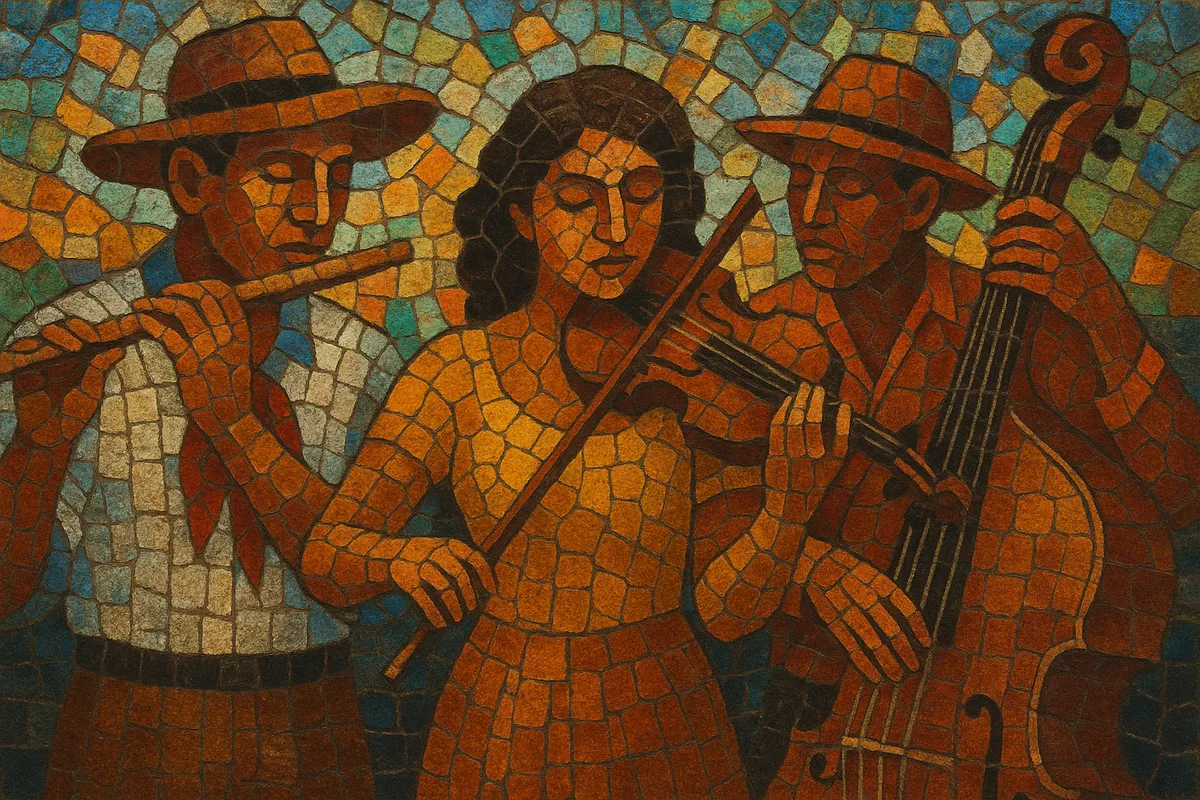Charanga is a Cuban dance‑music style and ensemble format distinguished by its elegant, salon‑influenced sound led by flute and violins over a light, syncopated Afro‑Cuban rhythm section. Emerging in Havana in the 1910s from the orquesta típica tradition, charanga shifted the danzón repertoire toward a more refined timbre by replacing brass and reeds with strings, wooden (later Boehm) flute, piano, bass, timbales, and güiro.
Charanga bands popularized danzón and later became central to the birth and worldwide spread of the chachachá and pachanga. Their arrangements balance European classical phrasing and counterpoint with Cuban rhythmic cells such as the cinquillo and the clave, often expanding into coro–pregón call‑and‑response and montuno sections. The style’s combination of grace, clarity, and danceable groove has influenced multiple Latin genres up to songo, timba, and strands of salsa.
Charanga crystallized in Havana in the 1910s as a lighter, string‑led successor to the brass‑heavy orquesta típica. Early leaders such as Antonio María Romeu helped formalize the ensemble known as charanga francesa: wooden five‑key flute, two to three violins, piano, string bass, timbales (paila), güiro, and sometimes claves. The repertoire centered on danzón, whose rhythmic DNA (clave and the habanera‑derived cinquillo) and salon elegance shaped the idiom.
Arcaño y sus Maravillas, featuring the López brothers (Orestes and Israel “Cachao”), transformed the danzón by adding more syncopated sections—the danzón‑mambo—which presaged the big‑band mambo era. In the early 1950s, Enrique Jorrín’s compositions with Orquesta América codified the chachachá within the charanga format, and Orquesta Aragón became a leading ambassador, refining the smooth string‑and‑flute sound and spreading it across the Caribbean and Latin America.
After the Cuban Revolution, charanga’s center of gravity extended to Mexico, Peru, and especially New York. José Fajardo, Johnny Pacheco (with Pacheco y su Charanga), Orquesta Broadway, and Charanga ’76 fueled a charanga renaissance, igniting the pachanga dance craze and feeding into early salsa and Latin boogaloo scenes. The charanga palette expanded with conga, electric bass, and modern recording techniques.
Charanga’s instrumentation and arranging vocabulary became a launchpad for rhythmically bolder hybrids. Orquesta Revé and later groups adapted charanga textures to changüí‑based grooves, while Los Van Van (initially charanga instrumentation) helped forge songo, paving the way to timba. Contemporary charangas retain the lyrical flute and strings while embracing modern harmonies, extended montunos, and electric timbres for today’s dance floors.
Use classic charanga forces: flute (wooden five‑key or Boehm silver), 2–3 violins (more for lush sections), piano, acoustic bass (or baby/electric bass in modern settings), timbales (with cencerro), güiro, and claves; add conga for a fuller modern groove. Keep the flute and violins as melodic protagonists.
Base the groove on 2‑3 or 3‑2 son/danzón clave. Employ the habanera‑derived cinquillo across piano, strings, and percussion. For danzón sections, keep a poised, medium tempo; for chachachá/pachanga, move to a crisp, even subdivision with clear güiro articulation and steady timbal bell patterns. Layer a tumbao bass that locks with piano guajeos.
Favor diatonic major/minor with functional progressions (I–IV–V, ii–V–I) enriched by secondary dominants and chromatic approach tones. Write elegant, singable flute melodies and violin counter‑melodies using parallel thirds/sixths and occasional suspensions. Piano guajeos should be interlocking, syncopated, and register‑aware to leave space for the flute.
Structure a danzón with a paseo (intro) leading into contrasting sections; insert a mambo (more syncopated) or shift to chachachá groove as a release. For extended dance numbers, add a montuno with coro–pregón call‑and‑response, flute improvisation, and string riffs. Use dynamic orchestration: thin textures for lyrical passages, unison string stabs for climaxes, and timbal fills to signal transitions.
Record flute with a warm, present tone and minimal reverb; double violins for sheen. Keep percussion tight and slightly dry so the güiro and timbal bell articulate the dance pulse. In live settings, balance the strings and flute above the rhythm section so dancers clearly feel the chachachá/pachanga articulation.


